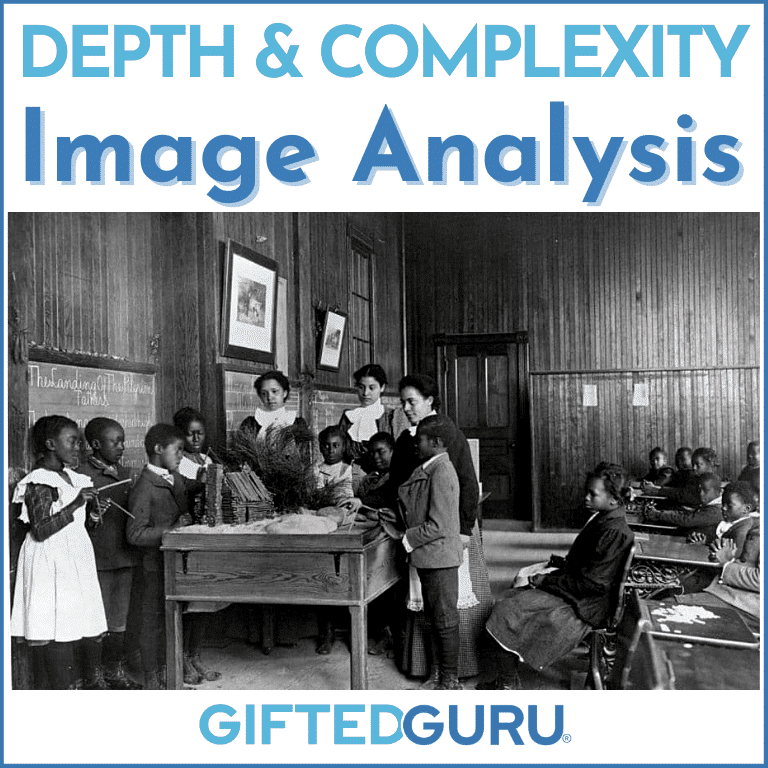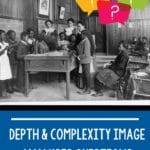Have you ever noticed that sometimes we make things worse when trying to make them better?
I’ve just recently come across this dynamic in my teaching practice.
I share resources for teachers on my little Teachers pay Teachers store. The TpT company has become very concerned with racial justice. That’s a good core value.
However, in trying to make things better, they’ve made some things way worse. I’ll give you an example.
The Teachers pay Teachers Rule that Was a Problem
I created a big Thanksgiving Depth and Complexity activity pack. In it, I included two images for students to analyze. One of them was this image:

This image was taken at the Whittier School in Hampton, Virginia. The Whittier School was built to educate the children of former enslaved people.
I wanted the students to analyze the photo using elements of Depth & Complexity.
Teachers pay Teachers has lots of rules now about what teachers can share in order to not offend people. It’s great…until it’s not.
One of the rules is that you cannot share:
Activities that ask students to embody (e.g. write or speak from) the perspective of an individual involved in a traumatic event
- Students imagine themselves as participants in traumatic events
- Students adopt the perspective of participants in traumatic events
Well, guess what? It’s a central tenet of teaching to ask students to see things from the perspective of others, and it’s also a central element of the Depth & Complexity framework.
In some places, this is a teaching standard, and it should be. How can I truly understand your experience if I don’t do my best to put myself in your shoes?
There is no way to consider slavery as anything other than traumatic. So, while what I wanted to include were deep, deep questions that looked at the experience of Thanksgiving through they eyes of these specific students in the image, I had to gloss over that and just ask questions that could have been about any group of students at any old school.
In their desire to make all of the resources unoffensive, Teachers pay Teachers has made them much, much weaker.
This is very sad because they are hampering the very result they want: an end to racial inequality and bias.
When teachers can’t discuss it, it cannot be confronted.
How I Solved My TpT Problem
When I mentioned to my friend Ayo, who creates resources for students with disabilities on Teachers pay Teachers, she understood exactly what I meant.
She understood how important it was for me to honor the children in the photo for who they were. She understood that I felt it was shallow and disrespectful to divorce them from their backgrounds to avoid possibly offending someone.
Ayo and her family just recently moved to Ghana, and her perspective as a woman of color was valuable to me. [Side note: I’m so obsessed with her YouTube channel about the move! YouTube thinks I’m interested in moving to Ghana now, and I’ve actually watched videos touring houses in Accra. No lie.]
Ayo suggested that I use my website to share my thoughts about why I felt like it was important to analyze the image from the perspective of these particular students – not just students in an old school. She suggested I could share the questions I wanted to write but couldn’t because of TpT’s rules here.
The Depth & Complexity Questions I Wanted to Write
So here are the questions I would have written if TpT had let me. The Depth & Complexity elements are indentified after the question. Even if you would not use this image in your content, the question examples may be helpful to you.
I’ll put the picture in again to make the questions easy to use.

- These children attend a school built to educate the children of former enslaved people. How do you think their family backgrounds influence how they feel about Thanksgiving as a holiday? [Multiple Perspectives]
- In what way are these children like the Pilgrims? In what way are they like the Wampanoag? In what ways are they unique? [Multiple Perspectives]
- Although these children have a very different background from you, what similarities do you think you share in the way you feel about holidays? [Patterns & Details]
- On the chalkboard, the phrase “The Landing of the Pilgrim Fathers” is written out. In what way are the Pilgrim fathers the fathers of these children? In what way are they not? (Ethics, Multiple Perspectives)
- Why do you think it just says “Pilgrim fathers” and not “Pilgrim mothers” on the board? (Unanswered Questions, Ethics)
- There is a log house on the desk, representing Pilgrim dwellings. Why do think there is not a Wampanoag wetu on the desk? (Unanswered Questions, Ethics)
- These children are very dressed up compared to how children dress for school today. What does that say about how they (or their parents) feel about school? Do you think they always dress like this or did they know their picture would be taken? (Details, Multiple Perspectives, Unanswered Questions)
- This photo was taken in 1899 or 1900, about 35 years after the end of the Civil War. That means that these children are probably the grandchildren of former enslaved people (the teachers may be the children of former enslaved people). How do you think they feel about Thanksgiving compared to the way their parents and grandparents felt? (Unanswered Questions, Multiple Perspectives)
- It is preferred to say “enslaved people,” rather than calling people “slaves.” Why do you think that is? Do you think that if you’re experiencing something traumatic that it makes a difference what people call you or the experience? If so, why? What effect does it have? (Language of the Discipline, Multiple Perspectives, Trends)
- If you could ask a student in this class one question about their lesson, what would you ask and what do you think they would answer? (Unanswered Questions)
After the discussion, I would lead students to form a Big Idea based on what they had considered. I would use this scaffold to help them develop their thinking:
Their background as the children and grandchildren of former enslaved people means that they may see Thanksgiving the same as I do in that __________________________________________________________________________. They may see it differently in that ______________________________________.
Then, I would give this Big Idea template:
To everyone, no matter what their backgrounds, Thanksgiving means ______________________________________________________________________________.
Depth & Complexity is for High-Level Thinking
The purpose in using the Depth & Complexity framework is to raise thinking levels in students. We can’t do that if we’re overly cautious.
The most distressing rule of all in TpT is that when you create a resource, you are supposed to ask yourself,
Am I equipped to tell this story?
I don’t know that I ever feel equipped to tell another person’s story, but I do know this: The stories must be told.
If not me, who? If only teachers of color confront issues of color, it will take forever to heal and to grow. It takes everyone.
Note: If you would like to see the entire resource, it’s available here (including all of the other, less controversial, questions about this image). You can get a free piece of the resource here. (Well, in additon to this massive list of questions.)
Wrapping Up:
Teaching well is almost always dangerous. There will be people who would shy away from these kinds of questions because there could be weirdness or awkwardness or discomfort. I understand that.
I also understand that we push through in love and respect so that our children’s children will have less discomfort, and their children even less. And then, one glorious day, we will all learn in shared respect, recognizing the dififculties of our shared heritage while celebrating the diversity that makes us so strong as a nation and as a world.
My classroom has been the scene of many an uncomfortable conversation. I’m okay with that. The greatest compliment I’ve ever received was when someone told me, “Everyone around you knows you stand for what is right.”
While I hope very much that this is not at all offensive to anyone, I would rather offend than lose the opportunity to teach, truly teach, what is right.
You May Also Like:
- I’ve written a lot more on Depth & Complexity. One of my favorites is this article on a common Depth & Complexity mistake, but you can read them all here.
- I love this article on making choice menus better. Am I allowed to love my own article? I hope so.
- As you probably know, Ian Byrd and I wrote the book (yes, the book) on Depth and Complexity. You can grab a copy here. No, really, you should.
**If you want to become a Depth and Complexity master, you can take the Depth and Complexity Course. Learn more here.
Sources:
- Johnston, Frances Benjamin, photographer. Thanksgiving Day lesson at Whittier. [or 1900] Photograph. Retrieved from the Library of Congress, <www.loc.gov/item/97507246/>.
- TpT Guidelines
- TpT Guidelines & Examples




